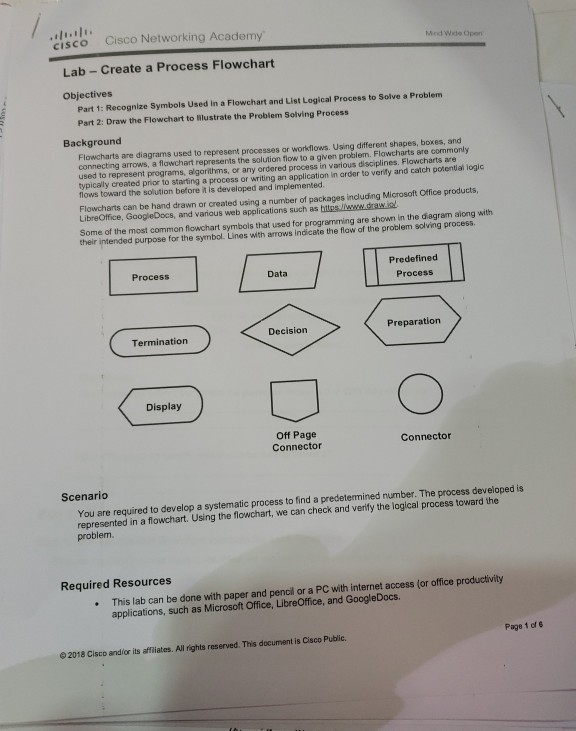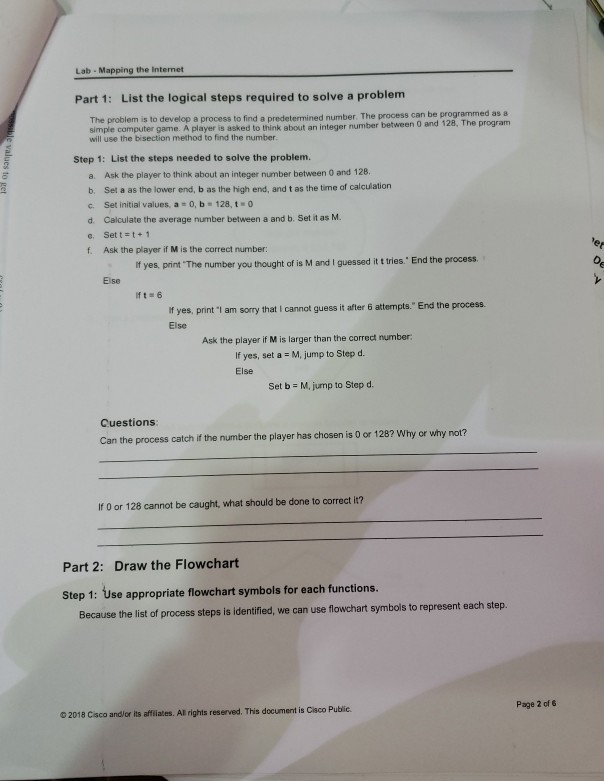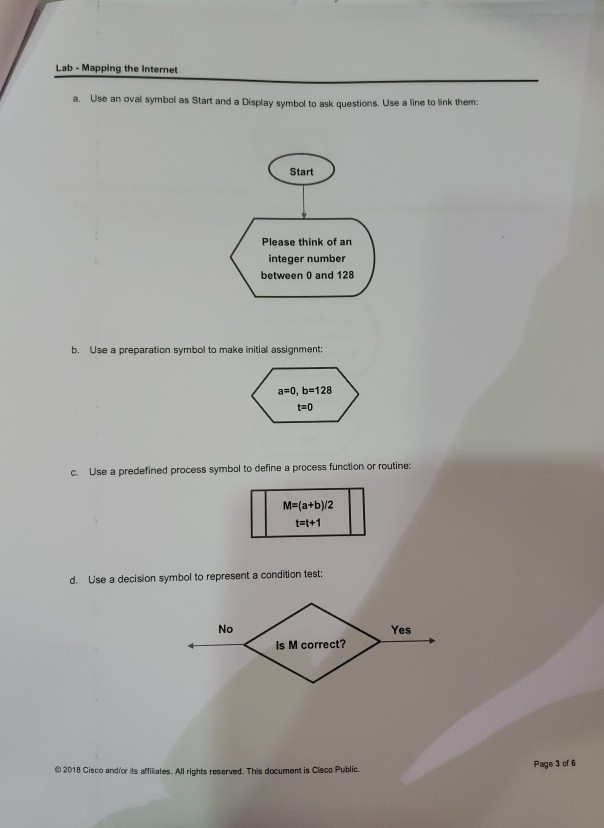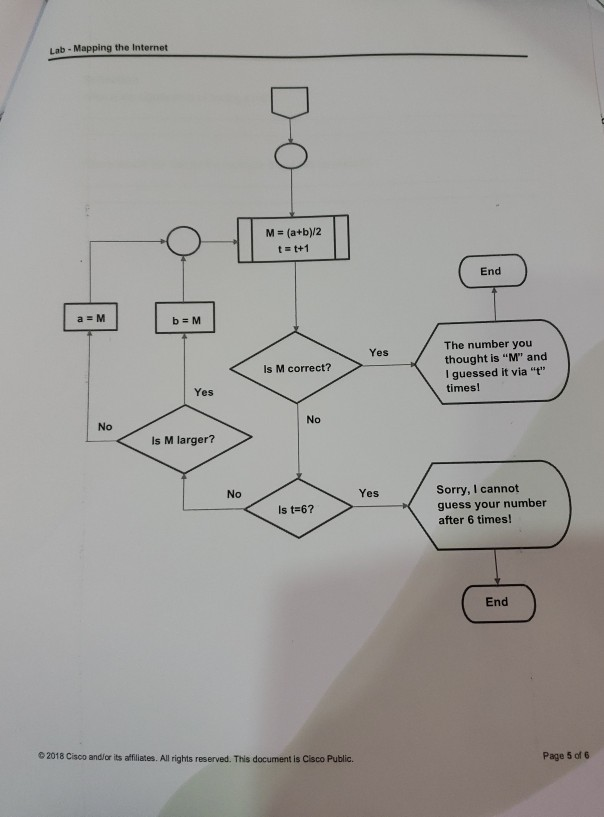Answered step by step
Verified Expert Solution
Question
1 Approved Answer
cisco Cisco Networking Academy Med Wide Open Lab-Create a Process Flowchart Objectives Part 1: Recognize Symbols Used in a Flowchart and List Logical Process to






cisco Cisco Networking Academy Med Wide Open Lab-Create a Process Flowchart Objectives Part 1: Recognize Symbols Used in a Flowchart and List Logical Process to Solve a Problerm Part 2: Draw the Flowchart to lillustrate the Problem Solving Process Background Flowcharts are diagrams used to represent processes or workflows. Using different shapes, boxes, and connecting arrows, a flawchart represents the solution flow to a given problem. Flawcharts are commonly used to represent programs, algorithms, or any ordered process in various disciplines. Flawcharts are typically created prior to starting a process or writing an application in arder to verity and catch potentiai logic flows toward the solution before it is developed and implemented. Flowcharts can be hand drawn or created using a number of packages including Microsoft Office products, LibreOffice, GoogleDocs, and various web applicatians such as hittpe lwww.crawi Some of the most common flowchart symbols that used for programming are shown in the diagram along with their intended purpose for the symbol. Lines with arrows indicate the flow of the problem solving proces8. Predefined Process ProcesS Data Decision Preparation Termination Display Off Page Connector Connector Scenario You are required to develop a systematic process to find a predetermined number. The process developed is represented in a flowchart. Using the flowchart, we can check and verify the logical process toward the problem. Required Resources This lab can be done with paper and penail or a PC with internet access (or office productivity applications, such as Microsoft Office, LibreOffice, and GoogleDocs. Page 1 of e e 2018 Cisco andior its affiates. All rights reserved. This document is Cisco Public. Lab - Mapping the Internet Part 1: List the logical steps required to solve a problem The problem is to develop a process to find a predetermined number. The process can be simple computer game. A player is asked to think about an integer nunm will use the bisection method to find the number programmed as a ber between 0 and 128, The progranm Step 1: List the steps needed to solve the problem. a. Ask the player to think about an integer number between 0 and 128. b. Set a as the lower end, b as the high end, and t as the time of calculation c. Set initial values, a 0, b 128, t d. Calculate the average number between a and b. Set it as M. e. Set tst+1 f. Ask the player if M is the correct number: If yes, print The number you thought of is M and I guessed it t tries End the process Else ift#6 If yes, print "1 am sorry that I cannot guess it after 6 attempts. End the process Else Ask the player if M is larger than the correct number If yes, set a M, jump to Step d. Set b M, jump to Step d Cuestions Can the process catch if the number the player has chosen is 0 or 128? Why or why not? If O or 128 cannot be caught, what should be done to correct it? Part 2: Draw the Flowchart Step 1: Use appropriate flowchart symbols for each functions. Because the list of process steps is identified, we can use fowchart symbols to represent each step. Page 2 of 6 O 2018 Csco and/or its affilates. Al rights reserved. This document is Csco Public Lab - Mapping the Internet Use an oval symbol as Start and a Display symbol to ask questions. Use a line to link them: a. Start Please think of an integer number between 0 and 128 b. Use a preparation symbol to make initial assignment: a:0, b 128 t-0 c. Use a predefined process symbol to define a process function or routine: M-(a+b)/2 t-t+1 d. Use a decision symbol to represent a condition test: No Yes Is M correct? Page 3 of 6 e 2018 Cisco and/or its affiates. All rights reserved. This document is Clsco Public. Lab Mapping the Internet e. Use a process symbol to represent an operation: Step 2: Draw the complete flowchart. Now we can use symbols to draw a complete flowchart. We will use the Off Page Connector and Connector to extend the flowchart to next page: Start Please think of an integer number between 0 and 128 0, b#128 t#0 a 2018 Cisco and/or its affliates. All rights reserved. This document is Cisco Public. Page 4 a Lab - Mapping the Internet M (a+b)/2 tt+1 End The number you thought is "M" and I guessed it via "t" Yes Is M correct? times! Yes No No Is M larger? Sorry, I cannot guess your number after 6 times! No Yes is t=6? End o 2018 Cisco and/or its affiliates. Allrights res erved. This document is Cisco Public. Page 5 of 6 Lab - Mapping the Internet Reflectiorn What is the significance of testing if t-6? Where should the test for the numbers 0 and 128 be placed? 2018 Cisco and/or its affiliates. Al rights reserved. This document is Cisco Public. Page 6 of 6 cisco Cisco Networking Academy Med Wide Open Lab-Create a Process Flowchart Objectives Part 1: Recognize Symbols Used in a Flowchart and List Logical Process to Solve a Problerm Part 2: Draw the Flowchart to lillustrate the Problem Solving Process Background Flowcharts are diagrams used to represent processes or workflows. Using different shapes, boxes, and connecting arrows, a flawchart represents the solution flow to a given problem. Flawcharts are commonly used to represent programs, algorithms, or any ordered process in various disciplines. Flawcharts are typically created prior to starting a process or writing an application in arder to verity and catch potentiai logic flows toward the solution before it is developed and implemented. Flowcharts can be hand drawn or created using a number of packages including Microsoft Office products, LibreOffice, GoogleDocs, and various web applicatians such as hittpe lwww.crawi Some of the most common flowchart symbols that used for programming are shown in the diagram along with their intended purpose for the symbol. Lines with arrows indicate the flow of the problem solving proces8. Predefined Process ProcesS Data Decision Preparation Termination Display Off Page Connector Connector Scenario You are required to develop a systematic process to find a predetermined number. The process developed is represented in a flowchart. Using the flowchart, we can check and verify the logical process toward the problem. Required Resources This lab can be done with paper and penail or a PC with internet access (or office productivity applications, such as Microsoft Office, LibreOffice, and GoogleDocs. Page 1 of e e 2018 Cisco andior its affiates. All rights reserved. This document is Cisco Public. Lab - Mapping the Internet Part 1: List the logical steps required to solve a problem The problem is to develop a process to find a predetermined number. The process can be simple computer game. A player is asked to think about an integer nunm will use the bisection method to find the number programmed as a ber between 0 and 128, The progranm Step 1: List the steps needed to solve the problem. a. Ask the player to think about an integer number between 0 and 128. b. Set a as the lower end, b as the high end, and t as the time of calculation c. Set initial values, a 0, b 128, t d. Calculate the average number between a and b. Set it as M. e. Set tst+1 f. Ask the player if M is the correct number: If yes, print The number you thought of is M and I guessed it t tries End the process Else ift#6 If yes, print "1 am sorry that I cannot guess it after 6 attempts. End the process Else Ask the player if M is larger than the correct number If yes, set a M, jump to Step d. Set b M, jump to Step d Cuestions Can the process catch if the number the player has chosen is 0 or 128? Why or why not? If O or 128 cannot be caught, what should be done to correct it? Part 2: Draw the Flowchart Step 1: Use appropriate flowchart symbols for each functions. Because the list of process steps is identified, we can use fowchart symbols to represent each step. Page 2 of 6 O 2018 Csco and/or its affilates. Al rights reserved. This document is Csco Public Lab - Mapping the Internet Use an oval symbol as Start and a Display symbol to ask questions. Use a line to link them: a. Start Please think of an integer number between 0 and 128 b. Use a preparation symbol to make initial assignment: a:0, b 128 t-0 c. Use a predefined process symbol to define a process function or routine: M-(a+b)/2 t-t+1 d. Use a decision symbol to represent a condition test: No Yes Is M correct? Page 3 of 6 e 2018 Cisco and/or its affiates. All rights reserved. This document is Clsco Public. Lab Mapping the Internet e. Use a process symbol to represent an operation: Step 2: Draw the complete flowchart. Now we can use symbols to draw a complete flowchart. We will use the Off Page Connector and Connector to extend the flowchart to next page: Start Please think of an integer number between 0 and 128 0, b#128 t#0 a 2018 Cisco and/or its affliates. All rights reserved. This document is Cisco Public. Page 4 a Lab - Mapping the Internet M (a+b)/2 tt+1 End The number you thought is "M" and I guessed it via "t" Yes Is M correct? times! Yes No No Is M larger? Sorry, I cannot guess your number after 6 times! No Yes is t=6? End o 2018 Cisco and/or its affiliates. Allrights res erved. This document is Cisco Public. Page 5 of 6 Lab - Mapping the Internet Reflectiorn What is the significance of testing if t-6? Where should the test for the numbers 0 and 128 be placed? 2018 Cisco and/or its affiliates. Al rights reserved. This document is Cisco Public. Page 6 of 6
Step by Step Solution
There are 3 Steps involved in it
Step: 1

Get Instant Access to Expert-Tailored Solutions
See step-by-step solutions with expert insights and AI powered tools for academic success
Step: 2

Step: 3

Ace Your Homework with AI
Get the answers you need in no time with our AI-driven, step-by-step assistance
Get Started


